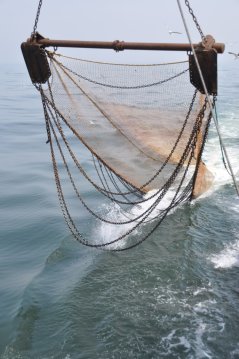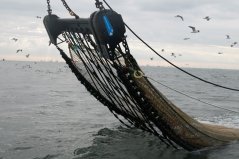
Penetration depth of beam trawling revisited
Beam trawls are known to penetrate relatively deep in the seafloor, but what about pulse trawl? BENTHIS has tested the two types of gears.
The penetration of a beam trawl into the seafloor compacts, displaces and re-suspends the sediment. In the 1990s, the penetration depth was estimated to range from 1 to 8 cm, depending on the sediment and rigging of the gear. The introduction of pulse trawl gear called for a revisit of this question.


During the first BENTHIS fieldwork campaign in the North Sea a modern multi-beam echosounder (Kongsberg EM2040) was deployed to investigate the differences in penetration depth between two types of beam trawls: the novel pulse trawl and the traditional tickler chain trawl. Such echo sounders produce detailed images of the seafloor from which we can derive the penetration depth of the trawls. For the experiment, we used relatively small beam trawls (4 m width), which are commonly used in the coastal zone. They are much smaller than their cousins that are used further out in the North Sea (12 m beams).
And there we went. The aim was to fish on experimental plots and detect damage to the seafloor fauna. We expected that we needed up to 4 passages for the pulse trawl while 2 passages of the traditional tickler chain beam trawls would suffice. The maximum penetration depth of the pulse trawl passages together (up to 4 trawls) was about 6 cm. For the traditional gear, almost double the penetration depth was reached (11 cm), with half the number of passages!

BENTHIS expedition leader Depestele expects that the differences in reality can be even larger: “The pulse trawl used in the experiment was the heavier version of two types used in the commercial fishery, while the deployed tickler chain beam trawl was a lighter version than typically used. For instance, we saw trawl tracks in the experimental plot of an unidentified 4m beam trawl, presumably a heavier beam trawl version, which were deeper than the measurements of the experimentally deployed gears.”
While this experiment confirms that beam trawls generally have a significant physical impact, these BENTHIS trials also highlight that a generic beam trawl is a theoretical concept with considerable variation in practice. The efforts undertaken by the fishing industry to improve the technical viability of their gears have clearly led to a modern version of the beam trawl that penetrates less deep in the seafloor.